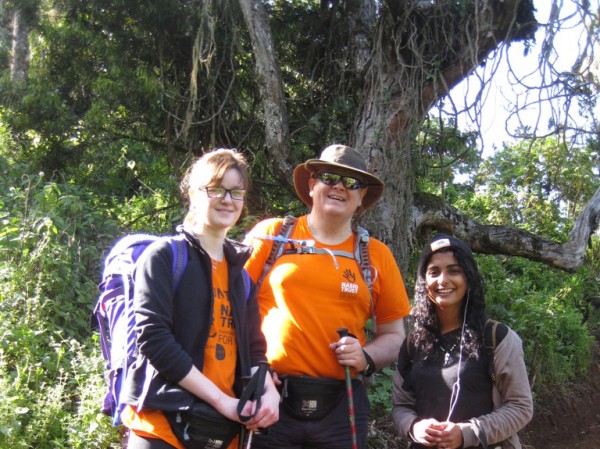Mountain Midlife Crisis
In February 2014 I climbed Mt Kilimanjaro in Tanzania! It has taken me nearly two years to write about the experience.
I decided in December 2013 that I would take on the challenge and I then had three months to get the gear, prove I was fit enough and raise £3,000 for the charity. Why did I do this? Several reasons, but to mention a couple: the end of my marriage, and the realisation that I had spent most of my adult life up to the age of 46 making excuses as to why I couldn’t do such things. So I went for it.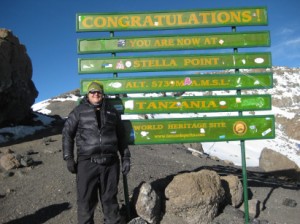
I sent many emails asking for sponsorship in those three months. The trip was to be followed by a visit to the projects that the Nasio Trust runs in West Kenya as they change the lives of hundreds of children orphaned or disadvantaged by poverty and HIV. By way of a follow up I promised that I would write about it on my return. Here it is and, yes, it is self indulgent.
Firstly, I would like to thank all who donated. I raised more than £5,500 with Gift Aid within a staggering 4 weeks of setting up my page. I deluded myself that this was due to popularity but as one of my dear friends put it in his comment: “Anything that is going to make you suffer that much is worth £100!” Colleagues from PA Consulting and clients from Pfizer and Otsuka Pharmaceuticals were particularly generous as were my friends and family.
There were only three of us in our party, Megan (my neighbour and friend) and Parina (a gap year student). With me being aged 46 and them 24 and 18 respectively it took approximately 12 hours for the guides to nickname me “Papa”! For three of us on this trip I am embarrassed to report that we had 2 guides, a chef, a waiter, a toilet carrier, a tent supervisor and 8 porters.
The climb
Our route was the eight day Lemosho Route. This is a favoured route as it is scenic and gives you more time to acclimatise. I acquired food poisoning on arrival in Africa and I carried that around with me until 2 days after the climb where I received treatment in Kenya. Imodium became my best friend!
We started the climb at 1,700M (5,577 Ft), which is actually higher than Ben Nevis. The first two days we hiked through rain forest and by the end of Day 2, despite wearing shorts, I was staggered to note that it went below freezing at night. The pace was pretty slow and the guides, Epa and Ema would say, “Pole, Pole Papa”. This was Swahili for “slowly slowly old man”. (Like I was going to race off to the top!). The frustratingly slow pace was essential as it is the only way to allow yourself to catch your breath and deal with the altitude.
Day 3 evening we were in the mess tent with the guides when I brought out the playing cards. I was able to entertain folk with some pretty mean card tricks. My new nickname was “Papa Magic” – and that stuck for the rest of the tour.
By Day 3 evening I am pretty sure I had altitude sickness as at midnight I was violently sick. That night there were many sounds of people vomiting around the campsite, not to mention the snoring and other bodily functions – this, apparently, was the camp where altitude sickness (and other symptoms) really kicked in. Day 4 was gruelling. We had a 10k hike that went took us up over 4,000m (over 13,000 ft) to the Lava Tower. Having been so ill the night before I was extremely exhausted. 10k at sea level would probably take 2-3 hours but here it was like a marathon. If they had said that I had to go home, I would have willingly gone. With a few drugs to stop the nausea and Diamox to help with the altitude I made it. I had little to eat and an early night.
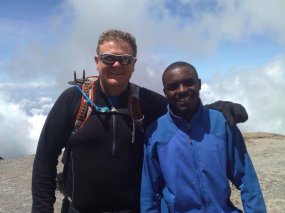
Eva the guide and me after the Barranca Wall
Day 5 was brilliant. I climbed the Barranca Wall which felt like a mini-personal victory after the miserable day before. The Barranca Wall is the only point on the climb where the walking sticks are put away and you scramble a rock face. The views were now amazing and we were way above the lower-level cloud base. And being over half way through there was no turning back, or so I thought.
Day 6 was a short day. We had a relatively short hike to Base Camp at 4,600M (15,000 ft). We had lunch there and were sent to bed by the guides. At 5pm we were woken for dinner and then sent to bed again. At 10pm we were woken up so we could start the final ascent at 11pm. So with head torches and 5 litres of water we started the final climb. We were already several degrees below freezing and we had 60MPH winds to contend with. Up we went at a very slow and safe pace. I have never been so cold. With the high altitude, your body just doesn’t generate anywhere near as much heat as it does at sea level. At about 3am I would have turned round, but we were so close. I was also mindful that a lot of people had sponsored me, and then there were my children at school telling their friends that “Daddy was climbing Kilimanjaro”. At about 6.30am the batteries on my head torch quit on me – but it was just as the sun rose which was truly amazing (both in terms of timing but also the view). With the sudden onset of daylight, Megan realised that she had lost peripheral vision in one eye due to altitude and was also starting to feel quite ill with the altitude. She was also the only one in our group who hadn’t taken Diamox to combat the symptoms of altitude sickness. We continued to climb. Not long after this we made Stella Point, which is at 5685M (18,652 Ft). This was a shock as I suddenly discovered we were on the crater rim and Uhuru Point the highest point was just a short walk round the rim. We were exhausted, Megan was ill and Epa the guide told me that I could go to Uhuru but he was seriously concerned about my energy levels for the descent.
At this moment Megan and I declared victory as Parina our other climber (and started the final ascent with a cigarette!) returned from Uhuru. We headed down, which was another 4 hour descent. It was at this point I started to miss the cartilage I had removed from my right knee. Once at Base Camp I slept for 30 minutes, packed my gear, had lunch and started the descent down to about 3,000M. This was exhausting having been awake all night climbing. We had trained for the climb but not the descent – my knees were finished! At 3,000M we camped for the last night. Day 8 was the final descent back down through the rain forest, and more importantly back to a shower, sanitation and beer! Oh how I scrubbed myself.
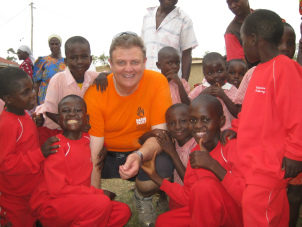
What was it all for?
So why put myself through this? After the climb Megan and I headed back to Kenya via Nairobi and then on to West Kenya where we visited the projects that the Nasio Trust fund. We visited two day care centres where children aged 3 to 6 receive education, food and some medical care. Each child has a story – most are orphans cared for at night by guardians. Some of the children have HIV. I was privileged to visit the homes of 3 orphans. One was a little 4 year old girl whose mother has HIV. When her father died her grandfather evicted them as the mother refused to be ‘inherited’ by the father’s brother and there were no sons. This little girl, her mother and sister lived in an 8 Ft square hut with holes in the roof. The next day I visited an inspirational woman in her eighties. She has been totally blind since the age of 12 and still walks 3 Km each day to fetch water. She cooks for her orphaned grandchildren and when we met her all she did was laugh. On the last day I met a 12 year old boy who looked like he was 6. He had HIV passed from his mother (now deceased) at birth. I was told of a 15 year old girl who missed school one week in every four because she could not afford sanitary towels. She had sex with an older man for 50 shillings (5 pence) to buy a sanitary towel so she could go to school for her exams. She now has HIV.
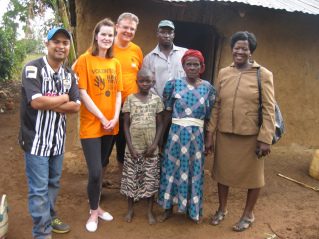
One of the visits to the inspirational grandmother. The big fella at the back died last year from undiagnosed diabetes.
There were many stories like this. Nasio changes the lives of children through running sustainable projects. They encourage local people to volunteer; children who are supported by Nasio are encouraged to give something back such as working on the farms or helping in the day care centres as they get older. The Guardians work on special projects, I saw them making re-usable sanitary towels so girls can continue their education and break out of the poverty cycle. I visited the farmland where Nasio grows its own food to feed the children. Money donated to the Nasio Trust is about ‘digging wells’ not ‘providing water’.
I was proud to have been a small part of this, and those of you who contributed can be sure that it was a worthy cause and the money is well invested for the children who need it.
What next?
Well, I didn’t make it to Uhuru so one day I would like to go back. So if I do I will probably send the usual begging letters and emails out, although I largely hope to self-fund it next time. Finally, for those of you interested in what the charity does please visit www.thenasiotrust.org.
Reproduced from www.oxfordnorwegian.wordpress.com by kind permission.
This post is listed in Climb Stories, Why Climb?
